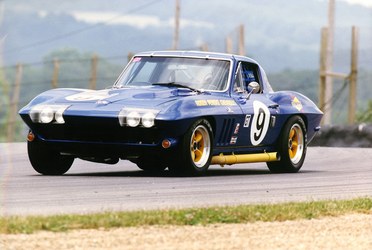Throwback Thursday - 1966 12 Hours of Sebring
January 21, 2016
1966 12 Hours of Sebring
Team Penske began its spectacular 50-year run in motorsports in 1966. Their first race was the 24 Hours of Daytona and they were successful in winning the GT class with drivers Dick Guldstrand, George Wintersteen and Ben Moore driving a Chevrolet Corvette Stingray.
The second start for the team came in the other prestigious American endurance race, the 1966 12 Hours of Sebring on the famed Sebring International Raceway circuit carved out of a former military airport runway system. This time, however, Team Penske would enter two Corvettes. A Stingray was entered in the GT class and the new addition, a Corvette GrandSport, would compete as a Prototype. After the success of the team at Daytona, Sunoco decided to sponsor both cars at Sebring. Wintersteen and Moore shared the driving duties in the No. 9 Stingray, with Guldstrand joining the newcomer to the team, “The Flying Dentist” Dick Thompson, in the No. 10 GrandSport.
At 10:30 am ET on March 26, 1966, the field of drivers set out for the Le Mans start which consisted of the drivers running across the track to their parked racecars, jumping in and speeding away. Thompson was the first driver of the No. 10 GrandSport and after the first lap, he was running solidly in the fourth position overall. Wintersteen was the first pilot of the Stingray, which he quickly moved to first in class.
Unfortunately, this version of the classic race was marred by several fatalities. Tragedy struck the event just past the four-hour mark as a fiery incident claimed the life of Canadian driver Bob McLean as his brakes locked up entering the hairpin turn. Upon barrel-rolling and making a hard impact with a telephone pole, his GT 40 burst into flames and he was unable to escape the wreckage.
With only two hours to go, Mario Andretti and Don Wester collected each other following a gearbox issue on Andretti’s Ferrari. Wester’s Porsche spun wildly out of control and sailed off the track into a group of spectators. Four lost their lives in this horrific incident, including a nine-year-old boy.
Wintersteen and Moore continued to lead the way in the GT class, eventually extending their lead to four laps, which adds up to almost 21 miles, on their way to the team’s second-consecutive class victory in as many starts. Guldstrand and Thompson did an admiral job in the heavier GrandSport against the more-exotic Ferraris and Porsches. However, with just a few hours left in the race, the GrandSport was forced to retire after contact with a lower entry resulted in heavy suspension damage.
Following the events of the 1966 12 Hours of Sebring, a contract was signed to move the event to West Palm Beach, Fla. as the track was deemed unsafe. However, heavy rains in 1967 made the West Palm track unsuitable, and the race was moved back to Sebring, but only after many safety improvements were made. There have been no safety issues at Sebring since 1966

